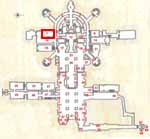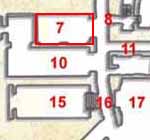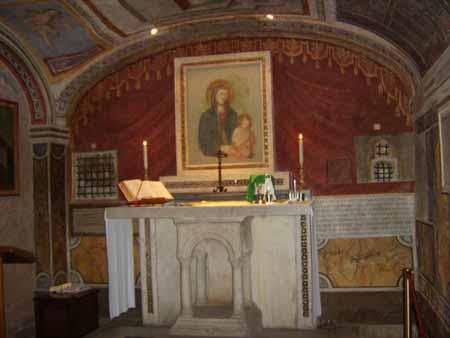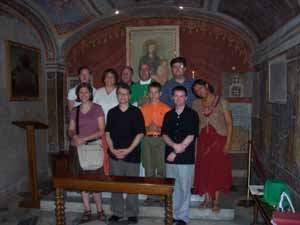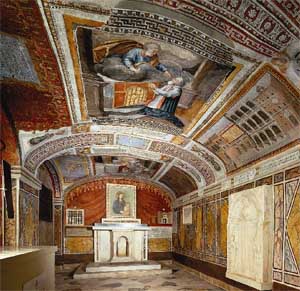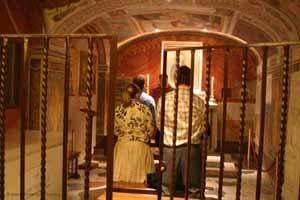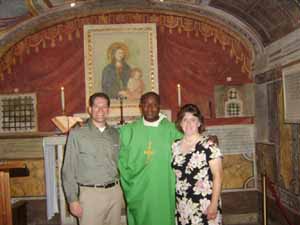| Grottoes
Vatican City Colonnade Saints Floorplan #2 |
| Altars
Monuments The History |
|
Related Links |
|
|
|
|
|
|
|
|
|
|
|
|
|
|
|
|
|
This is the oldest chapel in the area around the sepulcher of Peter. It originates from a very small oratory commissioned by Gregory XIII in 1580. It was created when the new basilica was under construction, under the paving of the southern transept (Altar of St Joseph), where the sainted popes Leo I, II, III and IV had been buried. In about 1592, pope Clement VIII had the room prolonged and joined to the new peribolos of the grottoes. In 1607, when Pope Paul V moved the relics of the sainted popes to the basilica, the oratory was dedicated to St Sebastian. Later that year, a mosaic representing the Apostle Paul was found during the demolition of the apse of the old basilica. It was brought to the chapel and placed on the new altar; the chapel was re-dedicated to St Paul. On 21 February, when pope Urban VIII had the present Marian image put in the altar, the chapel was given the new name Bocciata. The painting is a fragment of a medieval fresco framed in Cosmatesque marble elements. It was once believed to be the work of Simone Martini, but now it is generally attributed to Pietro Cavallini (1273-1321) or his workshop. The majestic and solemn Madonna (once probably enthroned) directs her intense gaze onto the spectator as she turns slightly to the Child on her lap, who she holds with her left hand and presents with the right one. The Child imparts His blessing as He looks down at the figure of teh commissioner of the work, now missing, whose one extended arm can still be seen. |
||||
The image was originally located in the portico of the old basilica, between the Ravenna Door and the Door of the Dead (to the south). It became famous after a miraculous event in 1440, according to the testimony collected by Nikolaus Muffel from the court of Emperor Frederic II in 1453. A drunken soldier, in a bout of anger for the florins he lost in a game, in a sacrilegious gesture hurled a stone or ball at the Virgin's face. The lesion is still visible on her left cheek. Drops of blood appeared on the image and fell down onto the stone paving. During the restoration of the portico in 1574, Pope Gregory XIII had the image removed and taken to the secretarium of the Basilica. In 1608, when the ancient building was demolished, the image was placed in the peribolos of the grottoes. It was the object of great veneration and became even more so in its present location dating from 1636. As recorded in the inscription to the right from the altar, attached to the wall and protected by iron grates, to the sides from the image of the Madonna there are two stones from the ancient paving of the portico, where, according to tradition, the miraculous blood fell. Their surface has been worn away by the touches of the faithful. Numerous ancient monuments used to be preserved in this chapel but during the restoration described above, it was simplified and the walls were whitewashed. During the thorough restoration of 2002, the paintings on the vault and on the walls below were given their original splendor. They were painted between 1618 and September 18, 1619, by Giovan Battista Ricci da Novara. To the right, on the upper level of the wall, is a series of images commissioned by Paul V. They preserve the memory of the monuments of the old basilica that had been demolished some 12 years earlier. The series continues in the next chapel of the Madonna of Partorienti. Today, several centuries later, the paintings are of enormous interest and paramount historical importance. Close to the entrance is The View of the Buildings in front of the Old Basilica. The represented buildings are recorded in the Latin inscriptions engraved on smal marble plates below the painting. Starting from the right is: the facade of the Apostolic Palace of Paul II; the bell tower of Leo IV and Loggia for the Blessings of Alexander VI; the mosaic of the Savior on the facade; the Oratory of St Mary in Turri of Paul I; the palace of the Archpriest of Leo III. In the next span is The View of the Oratory of John VII. In a style typical of the 17th Century, the fresco represents two walls of the ancient oratory that survived until 1608. It was decorated with 25 mosaic panels from 705-707 and it protected the medieval ciborium with the relic of the Holy Veil. The inscription says: SACALLVM
SS. SVDARII VERONIC(ae) The
oratory of the Holy Veil of Veronica This is an exact copy of the original by Ricci, made in 1949, when the deteriorating fresco was transferred onto canvas and placed on the opposite wall. The inscription below, dated 1609, comes from a different place and refers to another fresco of the oratory that no longer exists. In the center of the vault are two episodes from the "Stories of the Confession." Ricci inserted the frescoes in an older decoration and superimposed layers of paint are visible in some areas. The panel close to the altar represents St Servatius, the Bishop of Tongres. In the middle of the 4th century, Servatius came on a pilgrimage to Rome. As the inscription indicates, he was praying at the tomb and received a prophetic message from Peter concerning the future of his Church. In the other panel is St Amand, the Bishop of Maastricht, who according to tradition, received the order from St Peter to go and preach the Gospel in Gaul (the 7th century). On the left wall, in a lunette close to the altar, was the now lost painting of the ancient altar of St Anthony the Abbot. Still to be seen, instead, is the redone ancient mosaic of St Paul, originally from the apsidal decoration of Innocent III. To the right, still in its original location, is Ricci's fresco transferred onto canvas of the View of the Old Basilica.
At the entrance to the chapel is the simple sarcophagus of Cardinal Joseph Beran who died in exile in Rome in 1969. It was the wish of Paul VI that the Cardinal be buried here. For more than 3 centuries, from 1616 to 1949, the marble statue of St Peter enthroned was on display in this chapel, together with other precious monuments. Still visible, is the fake baldacchino and an inscription on the vault. On the right wall, in the vicinity of the altar, is a fragment of a Latin inscription from 732 with a relative explanatory plaque. It quotes one part of the decree of the synod of the Roman clergy held in front of the Confession of St Peter. Pope Gregory III had the text engraved on marble slabs. It established the cult of All Saints and of their numerous relics preserved in the Vatican basilica, to be held in the oratory founded by the pope himself. The text starts with the words (PE)TRO THEOPHANIO and lists the names of all the church dignitaries present at the synod, including the Deacon Zachary who succeeded Gregory III as Pope (741). To the right from the entrance is a marble fragment from the old basilica: the facade of the tabernacle made by Cardinal Lorenzo Cybo, the nephew of Innocent VIII, to hold the relic of the Holy Lance (1495). The work is attributed to the workshop of Andrea Bregno. The bas-relief represents two praying angels, dressed in flowing garments and spreading their wings. They are standing at the sides of a slightly open door on which is represented the spear and the sponge of the Passion of Christ. In the lunette above, under the starry paneled vault, is the image of Christ Victima, rising from the sepulcher while two heads of cherubs crown the upper corners.
|
||||
| Source: Roma Sacra The Vatican Grottoes, © Fabbrica of St. Peter's, June 2003 |
This independent website is not endorsed by or associated with the Vatican, the Fabbrica of St. Peter's, or any business organization
Contact:
stpetersbasilica@gmail.com
